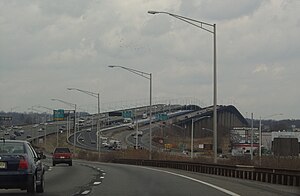Edison Bridge (New Jersey)
| Edison Bridge | |
|---|---|

The Driscoll Bridge (left) and the Edison Bridge (right).
|
|
| Coordinates | 40°30′32″N 74°18′02″W / 40.50889°N 74.30056°WCoordinates: 40°30′32″N 74°18′02″W / 40.50889°N 74.30056°W |
| Carries |
|
| Crosses | Raritan River |
| Official name | Thomas Alva Edison Memorial Bridge |
| Other name(s) | Ellis S. Vieser Memorial Bridge |
| Characteristics | |
| Design | Girder |
| Total length | 4,391 feet (1,338 m) |
| No. of spans | 29 |
| History | |
| Construction begin | September 26, 1938 |
| Inaugurated | December 14, 1940 |
| Opened | October 11, 1940 |
The Edison Bridge (officially the Thomas Alva Edison Memorial Bridge) is a bridge on U.S. Route 9 in New Jersey, spanning the Raritan River near its mouth in Raritan Bay. The bridge, which connects Woodbridge Township on the north with Sayreville on the south, was opened to weekend traffic starting on October 11, 1940, and was opened permanently on November 15, 1940. As of 2003, the bridge carries more than 82,000 vehicles daily and is owned and operated by the New Jersey Department of Transportation.
The design of the Edison Bridge was the direct responsibility of Morris Goodkind, chief engineer of the bridge division of the New Jersey State Highway Department, a position he had held since 1925.
The bridge is named for Thomas Edison. Construction on the bridge was started on September 26, 1938. The Edison Bridge was officially dedicated on December 14, 1940, with the ribbon cut by Mrs. Mina Edison Hughes, widow of the inventor. Also participating in the ceremonies were New Jersey Governor A. Harry Moore, and then Governor-elect Charles Edison, son of the inventor, along with the bridge's designer, Morris Goodkind.
The final design called for a bridge with 29 spans and an overall length of 4,391 feet (1,338 m). The nine spans over the river would consist of three continuous span girders of record-setting proportions. The main girder over the navigation channel would be 650 feet (200 m) in length, consisting of a 250-foot (76 m) span flanked by two 200-foot (61 m) spans, and would set a new U.S. record for length. The two other continuous girders were each 600 feet (180 m) in length, consisting of three 200-foot (61 m) spans.
The final cost of the bridge was $4,696,000. More than 65,000 cubic yards (50,000 m3) of masonry, 50 percent buried from sight, went into the foundations, piers, and deck of the bridge. Over 2,500,000 pounds (1,133.98 metric tons) of reinforcing steel and 19,000,000 pounds (8,618.26 metric tons) of structural steel were used.
...
Wikipedia
